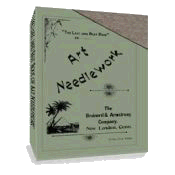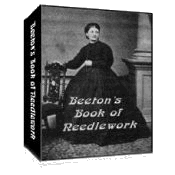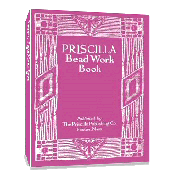How to Embroider Flower Stems
How to embroider flower stems seemed to be problematic to Victorian ladies. During this era, a woman’s embroidery was not only a piece of decorative cloth but also a showpiece of her knowledge of nature and good taste. Below is an article written in the late 1800’s by L. Barton Wilson, of the Art Amateur, Art Interchange, and Harper's Bazaar. It could be found in numerous magazines reminding embroiderers of the need for care and observation of nature if they cared to produce any embroidery articles that were worthy of display. Its widespread publication implied all embroiderers should heed this importance advice. The information contained in "How to Embroider Flower Stems" is as relevant today as it was then.
How to Embroider Flower Stems
In nearly all amateur work the lack of knowledge as to how to embroider flower stems is apparent. Like some other connecting links, this one seems to be missing, and the worker fails at a point where much expression, strength and beauty should be. Stems in nature are not merely bits of sticks by which the flowers are connected with the plants; they are rather an integral part of the plants and are full of individuality and character. Every stem is as unlike every other stem as flowers and leaves are unlike, and it is just the appreciation of such points of difference which makes our work appear natural.
A design for embroidery which is intended to suggest the natural does not do so because it is an actual copy, but because it brings out in an unmistakable manner the little characteristics by which we know the original in nature.
Since then stems are individual in themselves, the embroiderer will do well to observe from nature what their particular characteristics are.
So much for stems which are intended to seem natural. When we come to purely conventional work, we must conventionalize; but this does not mean that we become at once wholly stiff and expressionless. We conventionalize along the lines nature suggests. We do not need to throw away the natural and make something original and wooden, but to retain the same principles, merely conforming them to the idea of ornament more or less pure and simple. To illustrate, all stems are larger at the base than at the calyx of the flower, and it would be a violation of the laws of design as well as of nature (or more correctly because of the example of nature), if we should make them otherwise. Embroidery is essentially conventional and, while it has its degrees of conventionality, yet it must at all times embody in itself the evidence of its source, both in design and execution.
One cannot appeal to the needleworker to bring into her work a certain spontaneity without feeling that it is necessary to go farther and make an appeal to the designer. “Drawing is the probity of art,” and the needleworker has a hopeless task if she much lay her work, no matter how good, on a false foundation. However, the embroiderer is often alone at fault, because in the use of her material as in no other, the pencil or pigments, she is so likely to lose the outline. In no portion of the design is it easier to lose it than in the stems.
In the first place then, the worker must realize the importance of the stems in order not to feel that her work is practically finished with the completion of the flowers and leaves, and all that remains is to get the troublesome things in by some or any means.
In the second place she must know that in this, as in all her work, the simplest way is the best. There is a very real element of good sense in the universal tendency t accomplish a great deal with very little work. It often leads to bad results but in itself is a good plan because it leaves from for suggestiveness which is desirable.
A point to consider before deciding upon the method by which to embroider flower stems is whether it is lithe and supple, bearing a nodding flower; or stalky and firm, supporting leaves and blossoms of weight; or rugged and woody.
Further, the texture of the stem should be studied, that is when it has width enough to warrant this.
In the third place, the ground material should be considered, for this involves the style of the embroidery, — that is, whether it shall be full or “solid” or “half work” only.
Continue to Part 2 Continue to Part 3 Continue to Part 4
Return to top of How To Embroider Flower Stems Page
Return to Embroidery Instructions page.
Return to Home page.



 433 pages!
433 pages!

